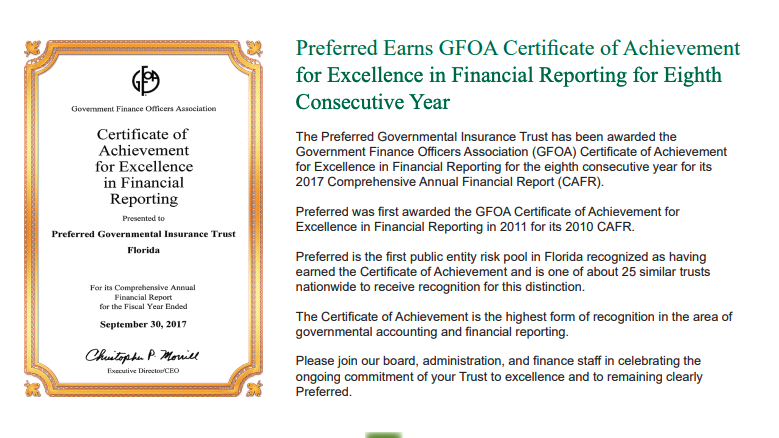By Public Risk Underwriters of Florida, Inc.
Preferred members have recently been sued by plaintiffs alleging the Public Entities’ website does not comply with the Americans with Disabilities Act by preventing disabled individuals from fully accessing all or a portion of the website’s content. This notice is to provide our members with information on the current ADA case law on website accessibility and additional insight on how to mitigate their exposure.
Title II of the ADA and Section 504 of the Rehabilitation Act of 1973 are applicable to State and local government entities regardless of federal funding status. The legislation requires that State and local governments provide qualified individuals with disabilities equal access to their programs, services, or activities. Although the language of the ADA does not explicitly mention the Internet, the Department Of Justice has taken the position that Title II covers Internet Website access. Public entities that choose to offer services through web-based applications, communicate with their constituents, or provide information through the Internet must ensure that individuals with disabilities have equal access to such services or information, unless doing so would result in an undue financial and administrative burden. An entity with an inaccessible website may also meet its legal obligations by providing another accessible way for individuals with disabilities to use the programs or services, such as a staffed telephone information line or alternative utility billing and payment services. However, such an alternative must provide an equal degree of access in terms of hours of operation and the range of options and programs available. For example, if job announcements and application forms are posted on an inaccessible website that is available 24 hours a day, seven days a week to individuals without disabilities, then the alternative accessible method must also be available 24 hours a day, 7 days a week. Since this poses obvious challenges for most public entities, updating your website is the easiest way to comply.
The Department of Justice oversees the enactment and enforcement of the ADA. The DOJ continuously stands by the ADA mandate applying to design characteristics that ensure government websites have accessible features for people with disabilities. In 2018, the DOJ was expected to engage in the rulemaking of website accessibility under the ADA; however, the Advanced Notices of Proposed Rulemaking has been withdrawn, and the proposed website regulations have been put on an “inactive” list. Therefore, no current efforts are being expended by the DOJ to adopt a formal regulation. Even still, the Department of Justice enforces the ADA website accessibility mandate on a case-by-case basis referencing the existing rules and will continue to do so until the proposed website regulations are finalized.
The Department of Justice oversees the enactment and enforcement of the ADA. The DOJ continuously stands by the ADA mandate applying to design characteristics that ensure government websites have accessible features for people with disabilities. In 2018, the DOJ was expected to engage in the rulemaking of website accessibility under the ADA; however, the Advanced Notices of Proposed Rulemaking has been withdrawn, and the proposed website regulations have been put on an “inactive” list. Therefore, no current efforts are being expended by the DOJ to adopt a formal regulation. Even still, the Department of Justice enforces the ADA website accessibility mandate on a case-by-case basis referencing the existing rules and will continue to do so until the proposed website regulations are finalized.
The World Wide Web Consortium (W3C) has published version 2.0 and more recently version 2.1 of the Web Content Accessibility Guidelines (WCAG 2.0 and WCAG 2.1). The Department of Justice and the Department of Education firmly uphold the view that the WCAG guidelines are applicable to websites, even with a lack of formal regulations by the ADA. Throughout these lawsuits, requirements to comply with the WCAG guidelines as well as other enforcement actions have been listed as part of the settlement.
In 2017, there were 814 federal lawsuits alleging ADA Title III violations. In January and February of 2018, we have already seen 349 suits of this nature filed. Based upon the increasing numbers of ADA website lawsuits and Title III lawsuits, Preferred is recommending all Members immediately assess their websites and other electronic information services to determine if the information is accessible based on the WCAG 2.0 Level AA guidelines.
Previously under the ADA, self-evaluations were originally used to determine if facilities, programs, and services were in compliance. As technology advanced over the years, website and other electronic information services accessibility has become an additional item to review on self-evaluations.
Each public entity should have an individual/employee(s) or third-party vendor, who is educated on the ADA requirements, to complete the self-evaluation and isolate any barriers. The individual/employee(s) or third-party vendor should create an ADA Action Plan, which outlines added steps in the event the website is non-compliant.
It is in the public entity’s best interest to contract a qualified IT representative to review the website based on the WCAG 2.0 Level AA guidelines. If the website is non-compliant, the entity should create a digital copy of the website prior to making any edits. This archived website can help provide additional details such as which aspects of the website were not accessible or how much of the website was not accessible. On the entity’s main website page, a notice of revision should be accessible to notify all individuals that the website will be updated to comply with the WCAG 2.0 Level AA guidelines and provide the contact information for the individual/employee(s) or third-party vendor listed in the above paragraph for questions or additional information.
Each public entity should be familiar with the WCAG 2.0 guidelines and can use the below links to help determine the website’s accessibility. Working with an IT technician or an individual who is educated on the ADA requirements, the following common barriers of non-compliance can be easily identified (please note – this is not an all encompassing list):
• Documents are not available in both PDF and HTML
• Photographs, logos, or graphs do not have accompanying text fields
• Web pages do not have individual text field headers
• Audio and video recordings do not have close captioning
• The text color blends in with the background color
Having an Action Plan already in place will prepare the entity for when the Department of Justice finalizes the website regulations. Since the Department of Justice has not decided on website accessibility regulations and lawsuits are continuing to increase, steps can be taken to minimize the possible exposure. Again, Preferred is recommending all Members immediately assess their websites along with other electronic information services to determine if the information is accessible based on the WCAG 2.0 Level AA guidelines.
Additional Information on ADA Compliance:
• WCAG 2.0 – www.w3.org/standards/webdesign/accessibility
• ADA Best Practices – www.ada.gov/access-technology/guidance
• Web Accessibility Evaluation Tool – www.wave.webaim.org
For further questions, please contact your regional Loss Control Representative or Mike Stephens, Senior Loss Control Specialist [email protected].



